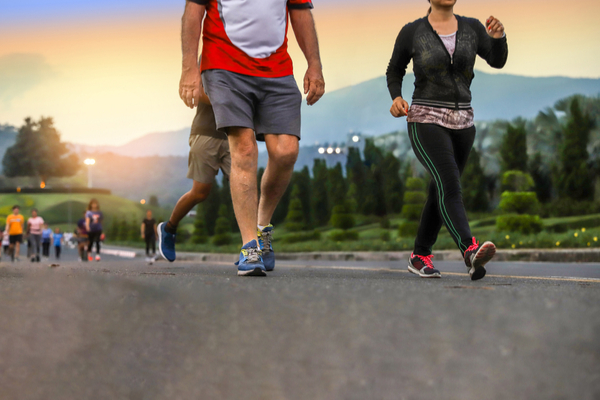“Fast-paced walking, when combined with healthy eating, is hugely effective for weight loss,” Art Weltman, PhD, director of exercise physiology at the University of Virginia, said in a recent interview with Health. And those simple steps can have a big impact on your overall health, cutting your risk of everything from heart disease to depression. But note that Dr. Weltman emphasized fast-paced walking, not a stroll about town. That doesn’t mean you have to pick up the pace to a race-walker speed—you just need to move at a more challenging rate – for you. “There is a strong relationship between intensity of exercise and fat-burning hormones,” says Weltman. “So if you’re exercising at a pace considered to be hard, you’re likely to release more of these hormones.” The best part: When women walk, deep abdominal fat is the first to go. That’s a scientific fact we can get excited about.
Another added benefit of walking at a quicker speed: Although you’re moving faster, power walking is still easier on the joints than running. “During walking one of your feet is always in contact with the ground,” says Weltman, “but during running there’s a float stage where your whole body is lifted in the air. Then you come back down and subject your body to the impact.”
To make sure your pace is on point, use these guidelines from Health magazine and exercise physiologist Tom Holland, author of Beat the Gym. Aim for 30 minutes at power-walk intensity three days a week. That time can be completed all at once, or you can break it up into spurts with recovery strides (stroll or brisk walk) in between.
- Stroll. Think window-shopping pace, or an intensity of 4 on a scale of 10. It burns about 238 calories an hour.
- Brisk walk. This means an effort of 5 or 6 on a scale of 10. It burns up to 340 calories an hour (at a 3.5 to 4 mph pace). While you can gossip about Mad Men, you need to catch your breath every few sentences.
- Power walk. You’re torching off approximately 564 calories an hour (at a 4 to 5 mph pace). Moving at this clip, using your arms to help propel you forward and taking longer strides, your effort should be a 7 or 8 on a scale of 10. Talking is possible only in spurts of three or four words, but you’d rather focus on breathing.
While you’re increasing the pace, make sure your form isn’t suffering, even though when it comes to walking, your body and brain generally know what to do. Here are a few tips on perfecting your form:
- Chin up. Your gaze shouldn’t be aimed at your feet, no matter how snazzy your sneakers are. Instead, focus on a point about 10 feet ahead of you. This will keep your stride longer and your neck comfortably in line with your spine.
- Activate your abs. When you brace your core—pulling your belly button toward your spine—you automatically trigger good posture.
- Squeeze your glutes. Your backside literally propels you through your walk. To get the most oomph—so you can go longer and faster—keep your glutes tight. Bad visual, good strategy: Imagine squeezing a winning lottery ticket between your cheeks.
And, when you’re ready to take it up a notch, here are some ways to add intensity to your walking workout:
- Add hills. When you hit the hills on a treadmill or in your neighborhood, you automatically make your workout more challenging.
- Go off-road. Head out for a light but brisk hike—the uneven terrain forces you to work harder. Sub this in for one of your weekly power walks.
- Swing your arms. With elbows bent at 90 degrees and hands in loose fists, move your arms in an arc, keeping elbows tight to your body. This helps drive you forward, says Weltman, and helps build upper-body strength.
- Make longer strides. Instead of taking more steps, “work on increasing your stride length,” Weltman says. “You’ll cover more ground.”
And the great thing about walking is, all you need is a good pair of shoes and the earth beneath your feet!
—
Photo Credit: aumnat / Shutterstock.com
